Proven whitetail hunters are using these tactics to find success in North America’s heartland
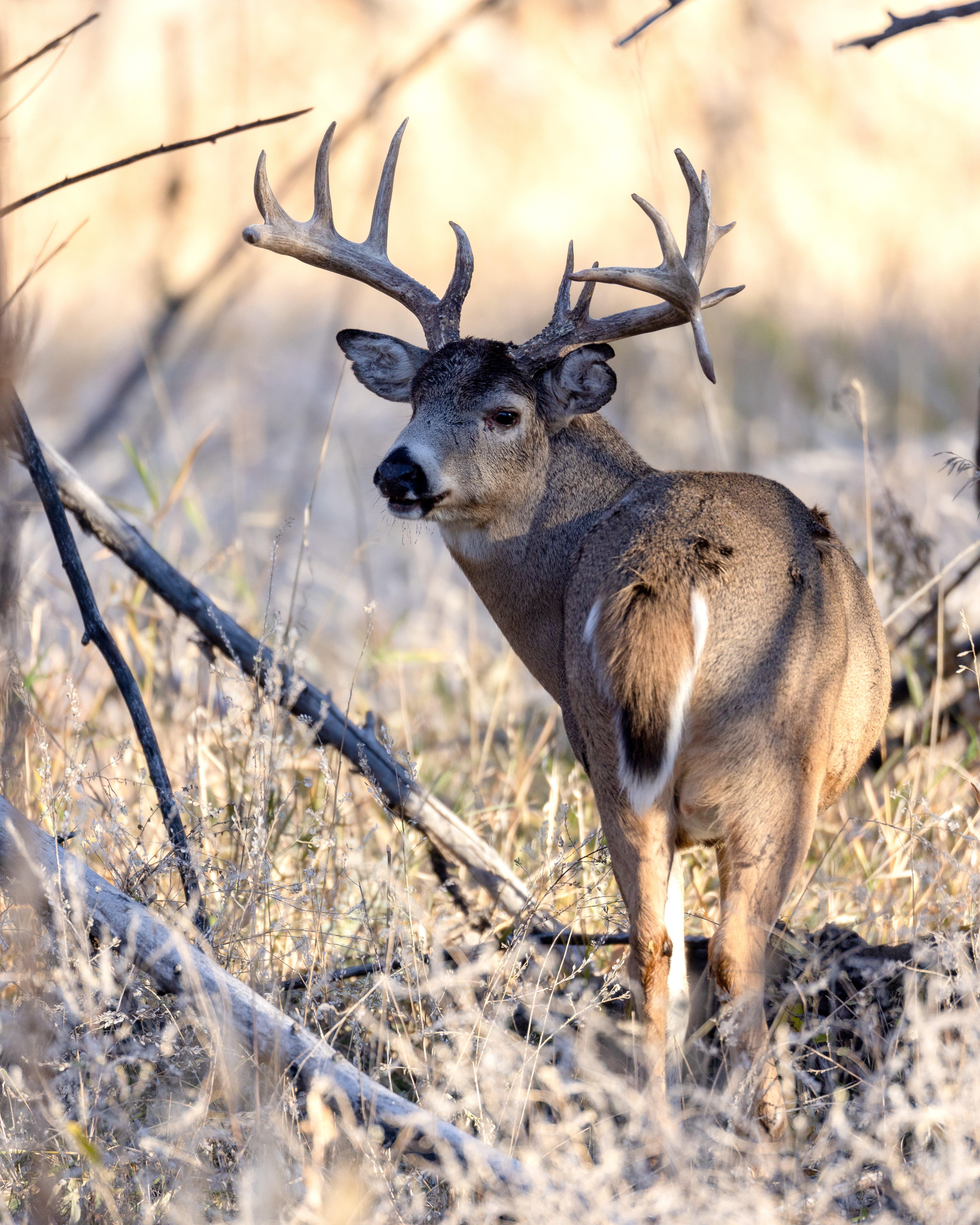
No region produces more big whitetail bucks than the Midwest. Image by Critterbiz
Footfalls in the nearby timber soon materialized into a stout 8-pointer followed by a gorgeous 14-pointer. The two mid-September bucks had briefly locked antlers about 10 minutes before they entered the alfalfa field, and as they began feeding, they tangled up again. That allowed me to draw my bow undetected, but the larger buck immediately turned toward me, offering no shot.
I became shaky and began letting down to await a better angle. I worried the buck would hear me or catch my movement. But, his head remained buried in the alfalfa. A few minutes passed, and slowly but surely, he turned broadside. I drew back again.
In the blink of an eye, my arrow flashed through his ribs, and the two bucks fled the field and stopped in the timber. A loud crash confirmed that my buck was down. I whispered, “Thank You, Lord,” as my knees were knocking together. My Wisconsin stud grossed in the 140s and impressively weighed 240 pounds, dressed.
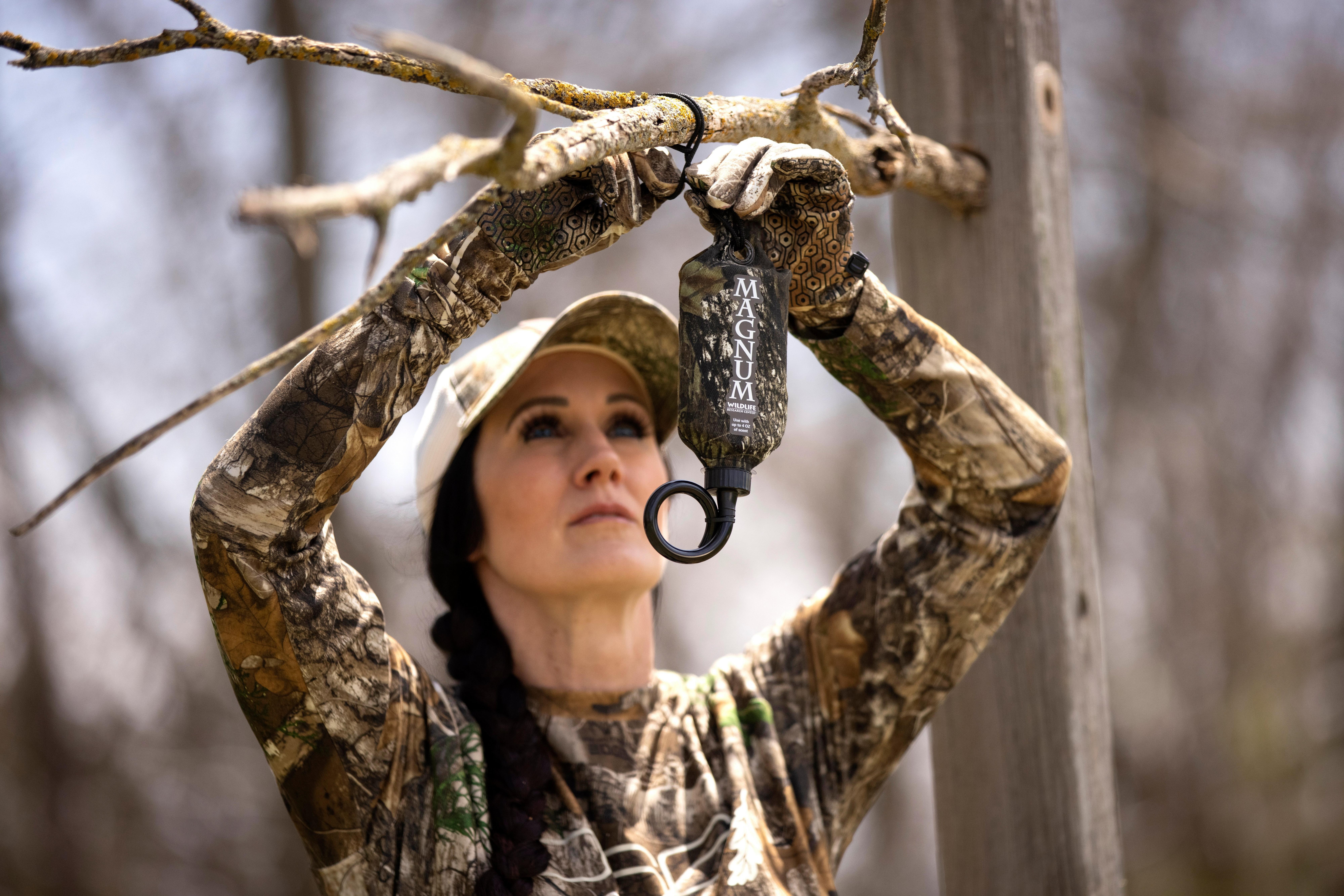
Scrape hunting is productive in the Midwest starting in late October. Image courtesy of Melissa Bachman
THE GOOD OLD MIDWEST
Not many whitetail hunters would contest this statement: There is no place to hunt whitetails like the Midwest. From Ohio to the Dakotas and Missouri to Minnesota, this region produces some of the largest antlers and body sizes in all of whitetail country. The Midwest has rich soils, typically reliable rainfall, booming agriculture and various cover types ranging from swamps to sloughs to huge timber country to conceal bucks from hunting pressure.
Historically, deer hunting for most hunters in this region involved some sort of “deer camp” atmosphere for the firearms seasons. While many families and friends still embrace that tradition, Midwestern hunters today are a diverse lot. Owning or leasing ground and spending hours and thousands of dollars to improve it is popular for those with the resources. There are also weekend warriors who work blue-collar jobs and hunt on public land on Saturdays and Sundays before returning to the Monday grind. Some folks have their stands and blinds positioned well before the season, while some adopt a hang-and-hunt strategy, finding fresh sign during the season and hunting over it immediately.
As for current trends, it seems that tree saddles and lightweight hang-and-hunt treestand gear are extremely popular among public-land hunters, especially those who annually hunt more than one state. Most hunters today, especially ones who’re shooting world-class bucks, rely heavily on cellular trail cameras to track deer movements on both public and private land. And where legal, lots of private-land hunters feed bait and minerals to some extent, even if they don’t actually hunt over it.
As for me, I’m a lifelong Wisconsin resident. I annually block out weeks of time to hunt a few different Midwestern states. I’ve hunted the Midwest with a bow, rifle, muzzleloader, and crossbow. I’ve hunted from September through early January on private and public land both. In 22 years, I’ve taken many bucks and does from treestands, ground blinds, and even by hunting actively on the ground. I have a lot of experience — successes and failures — under my belt. But, I don’t claim to know everything. So, I discussed Midwestern hunting strategies with a few fellow whitetail troops who live and hunt throughout the Midwest.
If you’re hunting the Midwest for the first time or simply hoping to add some knowledge to your game, the following strategies can be help you get your opportunity to score.
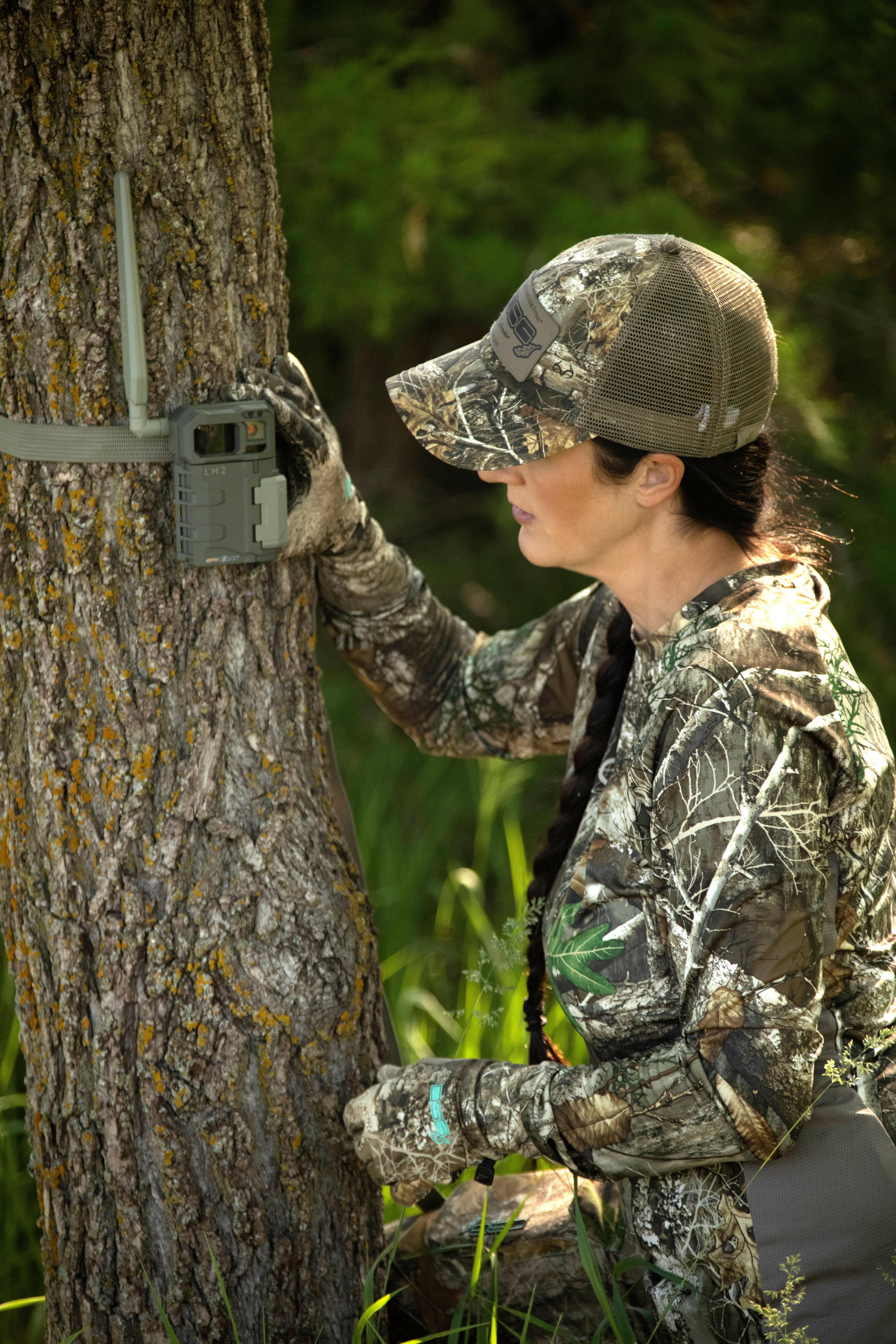
Scout properly and find that early season buck. Image courtesy of Melissa Bachman
SEPTEMBER
For Drake Lamb of Midwest Whitetail, September is a scouting month since Iowa’s archery season opens in October.
“September is a critical time to use trail cameras to dial in on bucks as they shift from summer food sources to fall ranges,” Lamb explained. “Our season doesn’t open until October 1, so it’s a big time for us to be moving trail cameras around in preparation for the upcoming opener.”
Melissa Bachman of Winchester Deadly Passion loves the predictability of mature bucks in states with earlier openers, such as Nebraska and South Dakota.
“When hunting whitetails in September, I focus heavily on using trail cameras,” Bachman said. “The more cameras I have in a location, the more knowledge I can compile of the bucks in the area and their movements. Bucks can be very patternable in early September.
“I firmly believe that even though September is usually hot, it’s one of the best times to hunt because I’m able to target bucks when they’re predictable,” she continued. “It’s important to watch the weather, too. I’ve had a lot of times during a front where the rain stops and then the deer move very well. And if it’s dry, hunting over water can be effective.”
While Bachman is a proponent of early-season hunting, she warns that hunting too much during the early season can sometimes do more harm than good.
“If you don’t have any big bucks patterned on your property,” she said, “don’t hunt constantly because you can burn out your spots. I’m not saying you shouldn’t hunt at all if you don’t have a big buck on camera, but be conservative. Also, if you have a limited number of vacation days, and don’t have a buck patterned, consider saving your vacation time for the rut.”
When I asked Ray Howell, accomplished bowhunter and founding father of Kicking Bear Foundation, how he capitalizes on huge bucks in September, he said that he spends more time scouting than hunting.
“Pre-season and in-season scouting are crucial,” Howell said. “Looking back on the early-season bucks I’ve taken, the average time I’ve spent scouting and then hunting them is three days. Many times I’ll see a mature buck for three to five days, and then they’ll disappear. A few days later, they’re back on the pattern again. When you identify that 3-day pattern, you have to wait for the right wind, but then get in there and hunt.”
Howell said that he watches food sources when he can, but that he also uses trail cameras when possible to figure out where bucks are bedding. Then, he has the most success with hunting between the bedding area and food source, which enables him to get in and out with little impact.
“A 189-inch buck I killed was on a pattern of leaving his bedding area, hitting an apple tree and then heading to an alfalfa field,” Howell explained. “He didn’t do it every night, but that was his pattern. I questioned if I did something wrong after sitting twice and not seeing him, but then on the third afternoon, he did it, and I put an arrow through him.”
Don’t Miss: HUNTER SHOOTS MONSTER BUCK AFTER HIS TRUCK BURNS DOWN
OCTOBER
When Lamb flips his calendar to October, he usually has bucks in mind to target based on his September trail-camera data at select food sources.
“My early and mid-October strategy is based almost solely around green food sources in the afternoons,” Lamb said. “Beans and corn are starting to dry out by this time in the Midwest, so having green food sources is important. Whether it’s clover, alfalfa or a late-planted bean field (those can be really good), deer are a little more patternable during this time. I also pay attention to scrapes and hang trail cameras over them. I try to watch for cold fronts, which can get bucks on their feet a little bit earlier than usual.
“By late October, scrapes get really hot,” he continued. “We’re not getting real aggressive and diving into the bedding areas just yet. We hunt over scrapes on the fringes of bedding areas. During the final few days of October, we determine where the resident does are feeding. When we can see does on a particular food source every single night, we assume that mature bucks will scent-check that spot in the daylight any day.”
Lamb also shared that he starts to rattle near bedding areas during October’s waning days. However, he has the most success with that about two weeks later. He believes it’s because the big mature bucks seem to lock down fairly early with the first hot does. They’re preoccupied and less responsive to calling until they break off the does.
While Bachman enjoys the early season, she admits that October can be challenging.
“October can be a difficult time to hunt,” she said. “There’s no question about it. You hear people talk about the ‘October lull.’ There is some downtime. If you have a really great property, it might be less pronounced. That being said, bucks can sometimes still be patternable during early October. Watch movements on your cameras, and also watch for cold fronts. But, if it’s still warm, focus on water.
“I like to make mock scrapes in October,” she continued. “A lot of bucks are interested in checking scrapes as the months goes on. I’ll create setups with a mock scrape, licking branch, rubbing post and waterhole all in one area in front of my stand or blind. The idea is to draw bucks to the stand or blind location where I can hunt them.”
Toward the end of October, Bachman starts deploying a decoy — her favorite way to hunt whitetails — in areas where she’s been capturing mature bucks on her cameras. She’s taken some tremendous bucks using a decoy. She also starts hunting daylight to dark, and rattling and calling frequently.
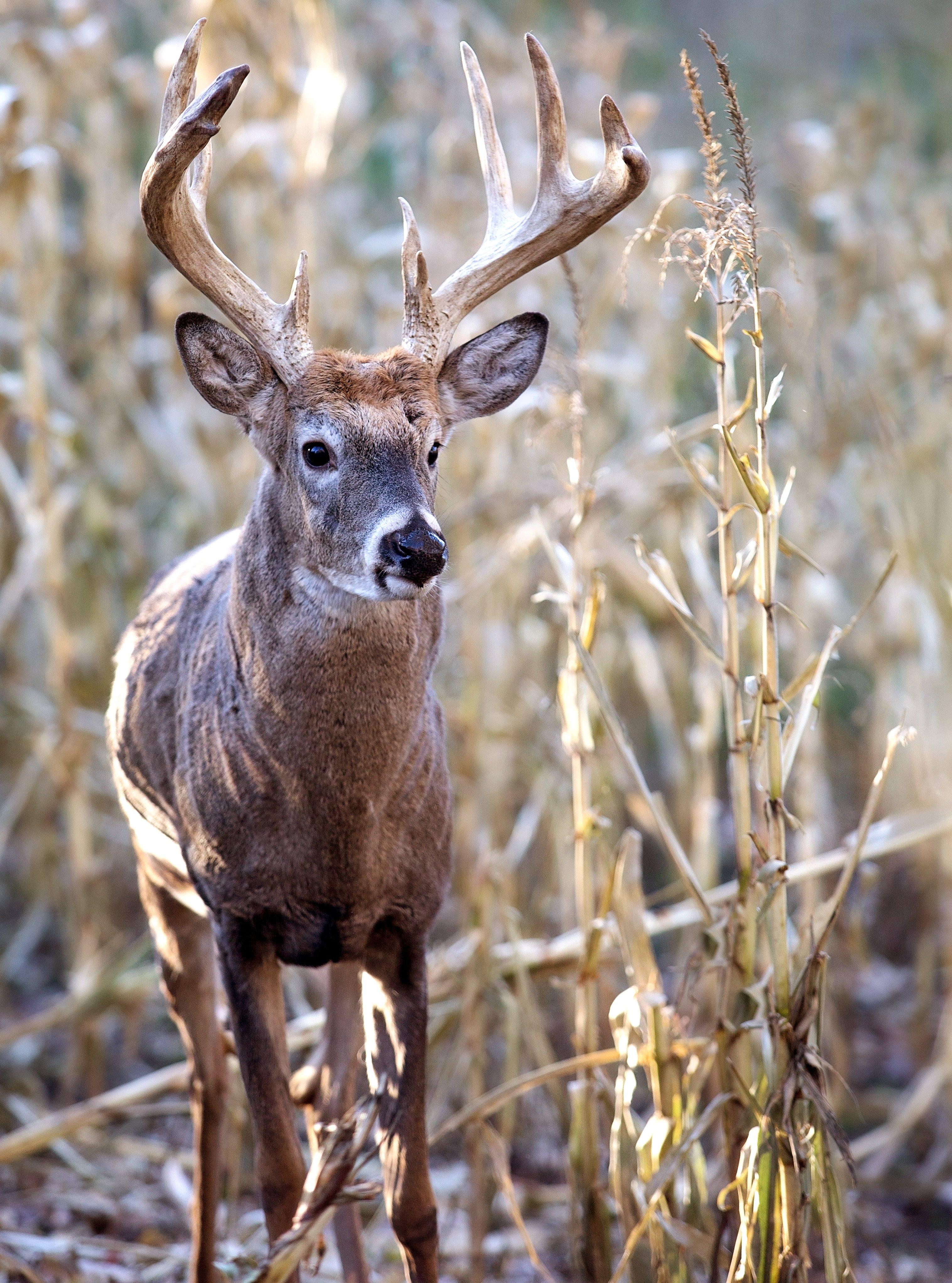
Never underestimate the power of the rut. Image by Critterbiz
NOVEMBER
Lamb said that when the rut hits and the bucks are less patternable, he starts really focusing on funnels and areas with high doe concentrations.
“On morning hunts, we start diving into doe bedding areas that we don’t hunt at all during the earlier part of the season,” he said. “I like to focus on funnels, pinch-points and ridges on the downwind edges. Access to hunting locations is always critical, but it becomes even more important when hunting bedding areas. If you can get in there discreetly before all of the does come to bed down, you’ll have a great chance of intercepting bucks as they scent-check the bedding area.”
Lamb shared that his afternoon hunts in November are typically food-based. The goal is to hunt high doe concentrations on food sources.
“Here in Iowa, my best success with rattling, grunting and snort-wheezing happens from November 15 through Thanksgiving,” Lamb said. “I think the biggest reason for that is because the big boys are looking for the last hot does. We’ve snort-wheezed in a lot of bucks during this time.
“Decoying is also effective during November,” he added. “Iowa is full of fields with lots of visibility. The main thing is to play the wind and know where bucks will circle downwind of the decoy. That’s huge. If you can try to influence how bucks approach the decoy by using open gates or other pinch-points, that helps.”
During late November as the rut turns into the post-rut, Lamb finds success by jumping back on food sources as bucks return to somewhat of a feeding pattern to replenish calories spent during the rut.
“If you have a dynamite food source, it’s a good time to jump on it,” he said. “Ones we’ve had success over are brassicas, beans, and corn. If I had my pick, it’d be standing or knocked-down corn. Corn seems to be king here, but we don’t overlook brassicas because they’re still green and deer love them.”
Bachman loves September, but November is her favorite because she can get very aggressive with a decoy and calling.
“In the areas I hunt,” she said, “it’s common to have brand new bucks showing up daily in different locations. It’s the one month when I don’t rely so heavily on my trail cameras. I don’t base my decision to hunt a location entirely on trail camera data. I’ll choose a spot that I have lots of confidence in because I know that bucks could potentially come from 1-2 miles away on any given day.
“I use a decoy every single day in November,” she added. “I also keep the mock scrapes going. I’ve seen many instances in which mock scrapes cause bucks to visit during the day rather than nocturnally. I use a Wildlife Research Center Magnum Scrape Dripper. It drips during the daytime only, and it really piques a buck’s curiosity. He wants to know who’s coming to the scrape.”
Bachman said that the downside to the rut is that deer are moving so fast that sometimes you cannot get a shot when you see a mature buck. She assured, though, that all of the activity and action makes it worthwhile.
As for me, I love to hunt open areas and glass for bucks, especially on large public-land parcels with room to roam. If I spot a big boy, I use a mix of stalking, calling (if necessary) and decoying to get him within bow range. If I spot nothing, I start hiking into obscure cover patches, listening and glassing as I go with the wind in my face. I killed my largest buck ever using that strategy.
Active ground hunting isn’t for everyone. To be routinely successful, you have to develop a feel for how to pick apart every single situation. You must be able to make lots of fast decisions. And, you have to balance both passiveness and aggressiveness — easier said than done.
If you desire to explore but aren’t good at moving in on deer, another idea is the hang-and-hunt strategy that I mentioned is growing in popularity. You can either bump a buck from his bed and start hunting there for the next few days to catch him coming back, or you can find fresh sign and hunt it immediately. Finally, mobile tree gear allows you to quickly tweak your setup. If you observe deer moving through a funnel 60 yards away, you can realistically take down your setup, move closer and be setup again within 20-30 minutes or so.
Most of the tactics we’ve covered so far are related to bowhunting, but gun seasons in several Midwestern states open in early to mid-November, such as Minnesota, which has a November 4 opener this fall. Gun tactics vary depending on the setting. A great way to go on pressured ground is to park in one spot that you have confidence deer will frequent as pressure moves them around. Arrive early and hunt from the beginning of legal shooting light to the end, for as many days as possible.
Another tactic Midwestern hunters have been using for years is driving deer. A group anticipates areas where deer are bedding, then sends standers to designated posting areas downwind from prospective deer. Drivers approach bedding areas with the wind at their backs, and that, combined with the commotion of them walking, moves deer toward the standers. Planned well, it can provide a lot of action, but there is also a safety aspect. Standers and pushers must control their line of fire and avoid all iffy shots. The other downside is that deer are often running, which makes for difficult shot opportunities that most hunters aren’t skilled enough to make.
Tracking is another option, particularly in the big woods with ample public land, such as in northern Wisconsin. Head out in the daylight following a night of snowfall and search for a large buck track. Plan to follow it all day, and be prepared to jump the buck a time or two before you lay eyes on him. If you’re lucky, you’ll spot him before he spots you, but this strategy takes immense patience and attention to detail.
Don’t Miss: HOW TO DEER HUNT THE NORTHEAST
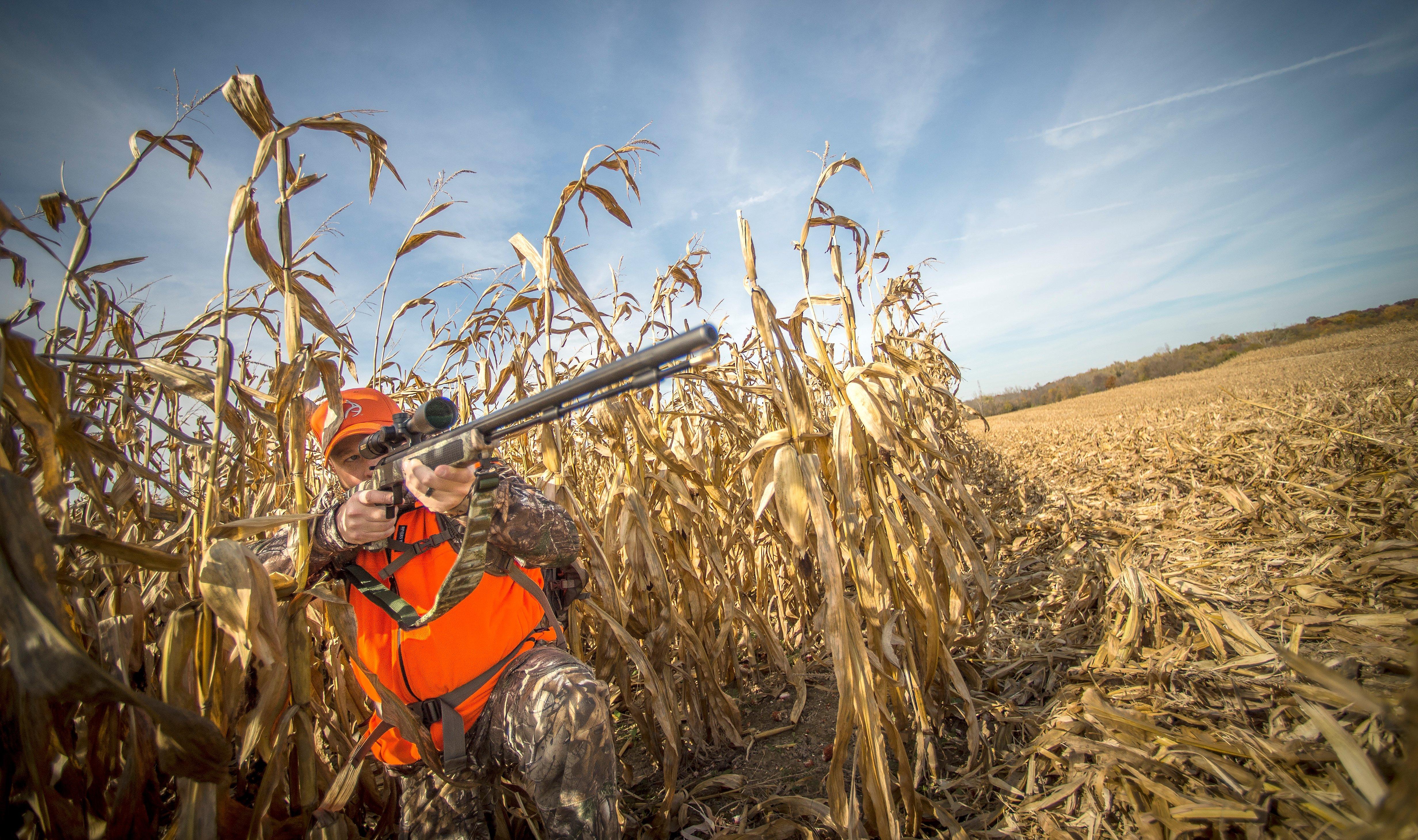
Late-season hunting over cut corn can be great. Image by Realtree
DECEMBER THROUGH EARLY JANUARY
December brings firearms seasons in some Midwestern states, and if you’re hunting pressured ground, the all-day sits in one location or drives can produce shot opportunities. If you’re on lightly pressured ground, sitting over food sources in the afternoons is a great approach that yields success for lots of Midwestern hunters.
“About 90 percent of our hunting during December is focused around food in the afternoons,” Lamb explained. “However, if you can catch a buck on a pattern of leaving a food source and going back to his bed, that can be a great time to swoop in on a morning hunt and kill him. On public land or other pressured ground, bucks are often leaving the food sources before daylight, so the afternoons are typically better.”
Bachman also buckles down on food sources during the tail end of the season.
“When December hits, I’m always looking for food,” she said. “I’m also anticipating cold weather. I want to be out there on the coldest days. I don’t hunt all day. I focus on the afternoons. You really want to be smart and hunt at the best times when a buck is most likely to walk out and give you a shot. You don’t want to burn yourself out, and you don’t want to burn stand locations out, either.
“If you hunt every single afternoon in one or two locations with a lot of deer and blow them out when you leave, you’ll find that deer sightings diminish each afternoon,” she continued. “If possible, the best way to hunt food sources during December is to be dropped off and picked up. Deer are pretty well accustomed to vehicles and farm equipment, so having someone come and pick you up gently nudges them off the food source and allows you to get out. You don’t want deer to associate your stand location with danger. If it’s legal, another option is to put an electronic coyote call out and run it at dark to clear the field.”
Howell said that during the right conditions, wintertime deer hunting can be like taking candy from a kid. But, just like his early-season strategy, in-season scouting is how he dials in on big deer.
“If you’re looking to take an average buck or a doe, you can just go sit where they feed,” he outlined. “But, to take a big buck, you have to find one and pattern him. In one state, I got up on glassing points with binoculars and observed the different deer groups in each area. I’d look for the giants I wanted to go after. Bucks are stressed during this time, and they want to feed. I had to intercept those bucks in places they were most killable. Most of the time, I wasn’t in a tree. I was on the ground in a brush line or snow pile. As long as I played the wind, I did really well.”

Iowa’s Drake Lamb took this 6 1/2-year-old buck by hunting over standing corn late in December. Great access to the hunting area was a major factor in Lamb’s successful hunt. Image by Midwest Whitetail
NO PLACE LIKE THE HEARTLAND
There are whitetails in nearly every state and many Canadian provinces, but the most widely acclaimed region in all of whitetail country is the Midwest where we grow them big. States like Ohio, Iowa, Illinois, Kansas, Missouri, and Wisconsin are regular producers of Boone & Crockett-class bucks. I’ve been writing Realtree Rack Reports on world-class bucks since 2015, and most of the bucks that fellow Realtree writers and I report on are taken in these states. Whether you live in the Midwest or plan to hunt it this fall, the tactics outlined herein could put a Midwest monster in your sights.
Don’t Miss: HOW TO DEER HUNT IN THE SOUTH










